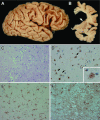Progranulin in frontotemporal lobar degeneration and neuroinflammation
- PMID: 17291356
- PMCID: PMC1805428
- DOI: 10.1186/1742-2094-4-7
Progranulin in frontotemporal lobar degeneration and neuroinflammation
Abstract
Progranulin (PGRN) is a pleiotropic protein that has gained the attention of the neuroscience community with recent discoveries of mutations in the gene for PGRN that cause frontotemporal lobar degeneration (FTLD). Pathogenic mutations in PGRN result in null alleles, and the disease is likely the result of haploinsufficiency. Little is known about the normal function of PGRN in the central nervous system apart from a role in brain development. It is expressed by microglia and neurons. In the periphery, PGRN is involved in wound repair and inflammation. High PGRN expression has been associated with more aggressive growth of various tumors. The properties of full length PGRN are distinct from those of proteolytically derived peptides, referred to as granulins (GRNs). While PGRN has trophic properties, GRNs are more akin to inflammatory mediators such as cytokines. Loss of the neurotrophic properties of PGRN may play a role in selective neuronal degeneration in FTLD, but neuroinflammation may also be important. Gene expression studies suggest that PGRN is up-regulated in a variety of neuroinflammatory conditions, and increased PGRN expression by microglia may play a pivotal role in the response to brain injury, neuroinflammation and neurodegeneration.
Figures





References
-
- Avrova AO, Stewart HE, De Jong WD, Heilbronn J, Lyon GD, Birch PR. A cysteine protease gene is expressed early in resistant potato interactions with Phytophthora infestans. Mol Plant Microbe Interact. 1999;12:1114–1119. - PubMed
-
- Parnell PG, Wunderlich J, Carter B, Halper J. Transforming growth factor e: amino acid analysis and partial amino acid sequence. Growth Factors. 1992;7:65–72. - PubMed
Publication types
MeSH terms
Substances
Grants and funding
LinkOut - more resources
Full Text Sources
Other Literature Sources
Medical
Miscellaneous

